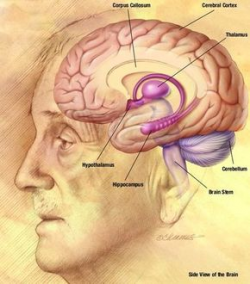(advertisement)

The Human Brain
Traumatic brain injuries occur when the head experiences either impact trauma, or penetrating trauma, and the brain is damaged as a result of the impact. Sometimes, the damage is minor, and after the initial concussion the victim of the injury experiences no further symptoms. In other cases, however, the result of the brain injury is a long term impairment of the person’s abilities. The sufferer may require supported living assistance – either for life, or while they go through a period of brain injury rehabilitation.
What does brain injury rehabilitation do?
Traumatic brain injury can cause many problems, including:
- Impairment of executive functions – such as the ability to make independent decisions and take care of themselves.
- Communication problems – they may have difficulty remembering words, putting together coherent sentences, and understanding idioms or humour.
- Lessened cognitive ability – tasks requiring dexterity or co-ordination may be difficult after a head injury.
The full extent of the damage will determine the type of treatment that is needed, and how extensive any supported living arrangements will need to be. In many cases, the effects of the damage are strongest immediately after the injury, but those effects are short term. As the swelling from the injury lessens, it’s common for the victim’s cognitive and communicative abilities to return.
(advertisement)
Treatment usually relies on re-teaching skills to the victim, rather than on treating the head injury itself. Early brain injury rehabilitation therapy focuses on improving the person’s orientation to their place, time, and situation, and getting them engaged in conversation. Stimulating speech and understanding can be a big help towards recovery.
Long Term Recovery
In the long term, the goal is to reduce the persons dependence on supported living aids, getting them moving and communicating. If the person has suffered from other injuries, and has been bed-ridden for a while, then they may need physical therapy as well as speech therapy, and aid from a neuropsychologist.
In cases where the injury is relatively minor, the individual may receive therapy at home, rather than in a medical centre. The hope is that being in a familiar environment, and having a degree of freedom and independence, will speed up recovery.
In more extreme cases, where there is a definite and pronounced impairment in the person’s abilities, the rehabilitation will focus on helping the individual regain lost skills, and helping them work around their impairment.
Coping with a brain injury can be difficult for both the injured person and those around them, but recovery is possible. It’s important to remember that the symptoms exhibited in the early stages are not necessarily an indication of what will happen in the long term.
Medical science has a long way to go before the deeper workings of the brain are fully understood, and a lot of progress is being made in the treatment of traumatic brain injuries each year, but so far, the most important things that can be done to help someone cope with brain injury in the long term is to offer them support, encouragement, and respect.
(advertisement)
This article was written by Amy Fowler on behalf of Voyage, who offer supported living and brain injury rehabilitation services.
The image is available in the Public Domain.
(advertisement)

